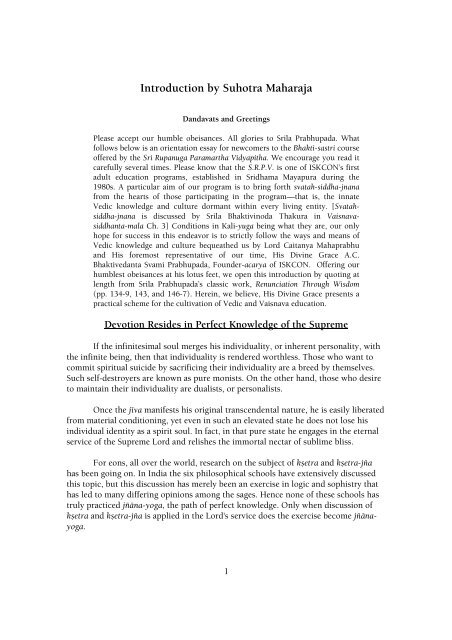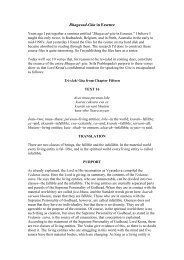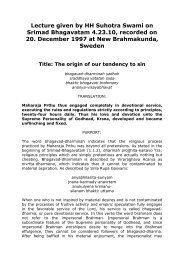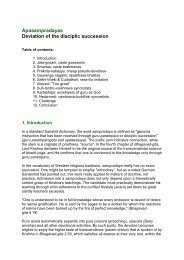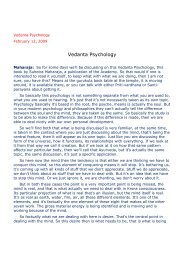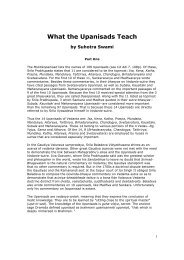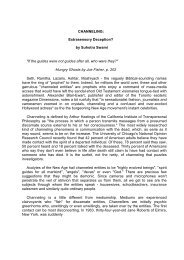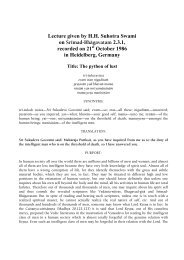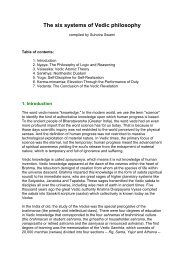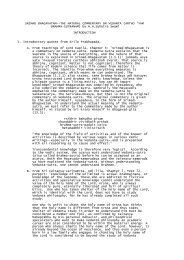Bhakti Sastri intro Suhotra Maharaja the printed version
Bhakti Sastri intro Suhotra Maharaja the printed version
Bhakti Sastri intro Suhotra Maharaja the printed version
Create successful ePaper yourself
Turn your PDF publications into a flip-book with our unique Google optimized e-Paper software.
Introduction by <strong>Suhotra</strong> <strong>Maharaja</strong>Dandavats and GreetingsPlease accept our humble obeisances. All glories to Srila Prabhupada. Whatfollows below is an orientation essay for newcomers to <strong>the</strong> <strong>Bhakti</strong>-sastri courseoffered by <strong>the</strong> Sri Rupanuga Paramartha Vidyapitha. We encourage you read itcarefully several times. Please know that <strong>the</strong> S.R.P.V. is one of ISKCON’s firstadult education programs, established in Sridhama Mayapura during <strong>the</strong>1980s. A particular aim of our program is to bring forth svatah-siddha-jnanafrom <strong>the</strong> hearts of those participating in <strong>the</strong> program—that is, <strong>the</strong> innateVedic knowledge and culture dormant within every living entity. [Svatahsiddha-jnanais discussed by Srila <strong>Bhakti</strong>vinoda Thakura in Vaisnavasiddhanta-malaCh. 3] Conditions in Kali-yuga being what <strong>the</strong>y are, our onlyhope for success in this endeavor is to strictly follow <strong>the</strong> ways and means ofVedic knowledge and culture bequea<strong>the</strong>d us by Lord Caitanya Mahaprabhuand His foremost representative of our time, His Divine Grace A.C.<strong>Bhakti</strong>vedanta Svami Prabhupada, Founder-acarya of ISKCON. Offering ourhumblest obeisances at his lotus feet, we open this <strong>intro</strong>duction by quoting atlength from Srila Prabhupada’s classic work, Renunciation Through Wisdom(pp. 134-9, 143, and 146-7). Herein, we believe, His Divine Grace presents apractical scheme for <strong>the</strong> cultivation of Vedic and Vaisnava education.Devotion Resides in Perfect Knowledge of <strong>the</strong> SupremeIf <strong>the</strong> infinitesimal soul merges his individuality, or inherent personality, with<strong>the</strong> infinite being, <strong>the</strong>n that individuality is rendered worthless. Those who want tocommit spiritual suicide by sacrificing <strong>the</strong>ir individuality are a breed by <strong>the</strong>mselves.Such self-destroyers are known as pure monists. On <strong>the</strong> o<strong>the</strong>r hand, those who desireto maintain <strong>the</strong>ir individuality are dualists, or personalists.Once <strong>the</strong> jéva manifests his original transcendental nature, he is easily liberatedfrom material conditioning, yet even in such an elevated state he does not lose hisindividual identity as a spirit soul. In fact, in that pure state he engages in <strong>the</strong> eternalservice of <strong>the</strong> Supreme Lord and relishes <strong>the</strong> immortal nectar of sublime bliss.For eons, all over <strong>the</strong> world, research on <strong>the</strong> subject of kñetra and kñetra-jïahas been going on. In India <strong>the</strong> six philosophical schools have extensively discussedthis topic, but this discussion has merely been an exercise in logic and sophistry thathas led to many differing opinions among <strong>the</strong> sages. Hence none of <strong>the</strong>se schools hastruly practiced jïäna-yoga, <strong>the</strong> path of perfect knowledge. Only when discussion ofkñetra and kñetra-jïa is applied in <strong>the</strong> Lord's service does <strong>the</strong> exercise become jïänayoga.1
The process of jïäna-yoga has been delineated in <strong>the</strong> Vedänta-sütra, <strong>the</strong>philosophical essence of <strong>the</strong> Vedas. The Supreme Lord, Kåñëa, accepts <strong>the</strong> authority of<strong>the</strong> Vedänta-sütra and considers <strong>the</strong> philosophical presentation proper. Up till <strong>the</strong>present day, every spiritual line, even in <strong>the</strong> impersonalist school, has based itsphilosophical authority on <strong>the</strong> Vedänta-sütra. And <strong>the</strong> Çrémad-Bhägavatam is <strong>the</strong>natural and faultless commentary on <strong>the</strong> Vedänta-sütra. This is Lord Caitanya'sopinion.Learned circles consider a disciplic line bereft of a commentary on <strong>the</strong> Vedäntasütrato be unauthorized and useless. Çrépäda Çaìkaräcärya's Vedänta commentary,entitled Çäréraka-bhäñya, is <strong>the</strong> main commentary of <strong>the</strong> impersonal, monistic school.Among <strong>the</strong> Vaiñëavas, besides Çrépäda Rämänujäcärya's commentary, Çréla BaladevaVidyäbhüñaëa's Govinda-bhäñya is <strong>the</strong> main commentary in <strong>the</strong> line of Lord Caitanya,known as <strong>the</strong> Mädhva-Gauòéya-sampradäya.Those who are keen to engage in deep discussions on <strong>the</strong> esoteric conclusionsof <strong>the</strong> scriptures should certainly delve into <strong>the</strong> philosophy of <strong>the</strong> Vedänta-sütra. Thepoint to be emphasized is that a well-versed Vedänta philosopher is not a philosopherin <strong>the</strong> line of Çaìkaräcärya but is actually a Vaiñëava spiritual preceptor, a liberatedsoul.According to <strong>the</strong> Vedas and <strong>the</strong> sages, <strong>the</strong> five gross elements are earth, water,fire, air, and e<strong>the</strong>r. Material nature is produced from a combination of false ego(ahaìkära), <strong>the</strong> ingredients of <strong>the</strong> material energy (mahat-tattva), and <strong>the</strong> cause of <strong>the</strong>mahat-tattva (prakåti). There are five knowledge-ga<strong>the</strong>ring senses and five workingsenses. The mind is <strong>the</strong> internal sense, <strong>the</strong> sixth knowledge-ga<strong>the</strong>ring sense. Form,taste, smell, touch, and sound are <strong>the</strong> five sense objects.We have already enumerated <strong>the</strong>se material ingredients in our description of<strong>the</strong> Säìkhya philosophy of <strong>the</strong> a<strong>the</strong>ist Kapila. The kñetra, or "field," is <strong>the</strong> combinationof <strong>the</strong> twenty-four ingredients mentioned above. When <strong>the</strong>se twenty-four ingredientsinteract <strong>the</strong> result is <strong>the</strong> transformation of material nature, which gives rise to <strong>the</strong>gross material body composed of five gross elements (païca-mahäbhüta), as a result ofmaterial desires, hate, enjoyment, lamentation, and so on. The shadow ofconsciousness in <strong>the</strong> form of mind and will are transformations of that field.What will soon be discussed is that <strong>the</strong> kñetra-jïa is completely different from <strong>the</strong>kñetra and its transformations. But to properly understand <strong>the</strong> knowledge concerning<strong>the</strong> kñetra and <strong>the</strong> kñetra-jïa, one must first cultivate at least twenty good qualitieslisted in <strong>the</strong> Bhagavad-gétä (13.8-12):Humility; pridelessness; nonviolence; tolerance; simplicity; approaching a bona fidespiritual master; cleanliness; steadiness; self-control; renunciation of <strong>the</strong> objects ofsense gratification; absence of false ego; <strong>the</strong> perception of <strong>the</strong> evil of birth, death, oldage, and disease; detachment; freedom from entanglement with children, wife, homeand <strong>the</strong> rest; even-mindedness amid pleasant and unpleasant events; constant andunalloyed devotion to Me; aspiring to live in a solitary place; detachment from <strong>the</strong>2
general mass of people; accepting <strong>the</strong> importance of self-realization; and philosophicalsearch for <strong>the</strong> Absolute Truth—all <strong>the</strong>se I declare to be knowledge, and besides thiswhatever <strong>the</strong>re may be is ignorance.Persons bereft of <strong>the</strong>se qualities are not eligible to discuss spiritual topics. Thefalse logicians mistake <strong>the</strong> above-mentioned qualities, which are meant to lead <strong>the</strong>conditioned soul to liberation, for mundane qualities acquired as a result oftransformations of <strong>the</strong> mind, such as lust, anger, and hate. But factually, <strong>the</strong> abovementionedqualities represent spiritual knowledge. Even if one accepts <strong>the</strong> falselogicians' argument that <strong>the</strong> qualities Lord Kåñëa enumerates in <strong>the</strong> Gétä asprerequisites for absolute knowledge are mental transformations, still we cannot agreethat <strong>the</strong>se transformations are equivalent to such qualities as lust, greed, anger, andillusion, which result from gross ignorance. One kind of mental transformation drags<strong>the</strong> soul down to depravity, whereas <strong>the</strong> o<strong>the</strong>r redeems <strong>the</strong> soul from doom. Bothdisease and medicine are products of material nature, yet one pushes a man toward<strong>the</strong> jaws of death, while <strong>the</strong> o<strong>the</strong>r saves him from destruction. So one must avoidbecoming <strong>the</strong> laughing-stock of society by accepting <strong>the</strong> foolish <strong>the</strong>ory of yata mata,tata path—"All ways lead to <strong>the</strong> Truth"—and on this basis professing that <strong>the</strong>medicine and <strong>the</strong> disease are one and <strong>the</strong> same.There is one quality among <strong>the</strong> twenty qualities Kåñëa lists that is especiallynoteworthy, and that is mayi cänanya-yogena bhaktir avyabhicäriëé: "Constant andunalloyed devotion to Me [Kåñëa]." The o<strong>the</strong>r qualities are required to cleanse <strong>the</strong>consciousness. Once <strong>the</strong> mirror of <strong>the</strong> mind is purified and <strong>the</strong> blazing fire of materialexistence extinguished, constant and unalloyed devotion to Lord Kåñëa begins toappear on <strong>the</strong> horizon of <strong>the</strong> heart. The great saintly spiritual master Çréla Narottamadäsa Öhäkura has sung, "When will my mind become purified and detached frommatter? Oh, when in that purified state will I be able to see <strong>the</strong> transcendental realmof Våndävana?"It is interesting to note that once constant and unalloyed devotion to LordKåñëa blossoms in <strong>the</strong> heart of a person, <strong>the</strong> o<strong>the</strong>r nineteen qualities automaticallymanifest in him. As mentioned in <strong>the</strong> Çrémad-Bhägavatam (5.18.12), yasyästi bhaktirbhagavaty akiïcanä sarvair guëais tatra samäsate suräù:All <strong>the</strong> demigods and <strong>the</strong>ir exalted qualities, such as religion, knowledge andrenunciation, become manifest in <strong>the</strong> body of one who has developed unalloyeddevotion for <strong>the</strong> Supreme Personality of Godhead, Väsudeva.By patiently collecting ten, twenty, thirty rupees daily, one will someday have amillion rupees. But if one comes upon a million rupees all at once, one does not haveto endeavor separately to collect ten, twenty, or thirty rupees and waste valuable time.Similarly, when one develops unalloyed devotion to Lord Kåñëa, all <strong>the</strong> o<strong>the</strong>r abovementionedqualities automatically adorn that person without extra effort. On <strong>the</strong> o<strong>the</strong>rhand, one who leaves aside unalloyed devotion to Lord Kåñëa and tries to cultivate <strong>the</strong>o<strong>the</strong>r nineteen qualities separately may temporarily receive wealth and honor, but he3
This material nature, which is one of My energies, is working under my direction, Oson of Kunté, producing all moving and nonmoving beings. Under its rule thismanifestation is created and annihilated again and again.The Gétä verse under discussion (14.3) gives a clearer understanding of <strong>the</strong>o<strong>the</strong>r verse (9.10).Wherever <strong>the</strong> word jïäna appears in <strong>the</strong> Vedic literature, it should beunderstood to mean sambandha-jïäna, knowledge of <strong>the</strong> relationship between <strong>the</strong>Lord and His energies. It does not refer to <strong>the</strong> impersonalist concept of <strong>the</strong> Supreme.After a person understands sambandha-jïäna, he comes to <strong>the</strong> stage of abhidheyajïäna,knowledge of how to act in his relationship with <strong>the</strong> Supreme Lord. This isdevotional service, practiced by liberated souls. The mature stage of abhidheya-jïänaleads one to love of Godhead, <strong>the</strong> ultimate goal of all living entities.In <strong>the</strong> Çrémad-Bhägavatam (10.87.30), one of <strong>the</strong> four Kumäras, Sanandana,recites to an assembly of sages in Janaloka <strong>the</strong> prayers <strong>the</strong> personified Vedaspreviously recited to <strong>the</strong> Supreme Lord. One of <strong>the</strong> prayers is as follows:aparimitä dhruväs tanu-bhåto yadi sarva-gatästarhi na çäsyateti niyamo dhruva netarathäajani ca yan-mayaà tad avimucya niyantå bhavetsamam anujänatäà yad amataà mata-duñöatayäIf <strong>the</strong> countless living entities were all-pervading and possessed forms thatnever changed, You could not possibly be <strong>the</strong>ir absolute ruler, O immutable one. Butsince <strong>the</strong>y are Your localized expansions and <strong>the</strong>ir forms are subject to change, You docontrol <strong>the</strong>m. Indeed, that which supplies <strong>the</strong> ingredients for <strong>the</strong> generation ofsomething is necessarily its controller because a product never exists apart from itsingredient cause. It is simply illusion for someone to think that he knows <strong>the</strong> SupremeLord, who is equally present in each of His expansions, since whatever knowledge onegains by material means must be imperfect.The last word in knowledge is certainly not self-realization or Brahmanrealization. There is more to realize—namely, that <strong>the</strong> jéva is <strong>the</strong> eternal servant ofLord Kåñëa. This realization is <strong>the</strong> awakening of supramental consciousness, and <strong>the</strong>activities a jéva performs in such consciousness are <strong>the</strong> beginning of his eternal life.When <strong>the</strong> jéva performs all his activities under <strong>the</strong> direction of <strong>the</strong> Lord's internal,spiritual energy, he enjoys eternal transcendental bliss, which is a billion times greaterthan <strong>the</strong> happiness of Brahman realization. The difference in transcendental joybetween <strong>the</strong> two is like <strong>the</strong> difference between <strong>the</strong> vast ocean and <strong>the</strong> water collectedin a calf's hoofprint.An Examination of <strong>the</strong> Above5
These excerpts from Renunciation Through Wisdom (or Vairagya-vidya in <strong>the</strong>original Bengali) serve as Srila Prabhupada’s own <strong>intro</strong>duction to <strong>the</strong> Vedic process ofknowledge. The portions of his book quoted above are sub-headed Devotion Residesin Perfect Knowledge of <strong>the</strong> Supreme. That is as per <strong>the</strong> English-language BBTedition. We believe <strong>the</strong>se eight words sum up <strong>the</strong> aim of our <strong>Bhakti</strong>-sastri course.From beneath <strong>the</strong> flag he planted in <strong>the</strong> form of this sub-heading, His Divine Graceissued forth a most remarkable scheme of education. It deserves our careful attention.Srila Prabhupada begins by dismissing a class of aspiring spiritualists whosegoal is to merge into God, <strong>the</strong> infinite being. “Pure monists,” Srila Prabhupada terms<strong>the</strong>m, and less charitably, “self-destroyers” and seekers of “spiritual suicide.” They are“a breed by <strong>the</strong>mselves” who deem individuality “worthless.”His Divine Grace turns to transcendentalists he calls dualists or personalists.They manifest <strong>the</strong>ir eternal transcendental nature without losing <strong>the</strong>ir individualidentity as spirit souls. In <strong>the</strong> state of pure identity <strong>the</strong>y engage in <strong>the</strong> eternal serviceof <strong>the</strong> Supreme Lord and as a result relish “<strong>the</strong> immortal nectar of divine bliss.”It must be noted that Srila Prabhupada leaves no doubt that <strong>the</strong> path of perfectknowledge of <strong>the</strong> self known as jnana-yoga is followed by <strong>the</strong> personalists, not by <strong>the</strong>so-called monists. The doctrinal basis of <strong>the</strong> jnana path is an ancient text namedVedanta-sutra. As <strong>the</strong> philosophical essence of <strong>the</strong> Vedas, even <strong>the</strong> monists respect itas authoritative. Indeed Sri Krsna Himself accepts <strong>the</strong> authority of Vedanta; moreover,<strong>the</strong> opinion of His incarnation in this age, Lord Sri Caitanya Mahaprabhu, is thatSrimad-Bhagavatam is <strong>the</strong> natural commentary on Vedanta-sutra.Jnana-yoga begins with research into <strong>the</strong> subject of ksetra and ksetra-jna. Thefirst, ksetra, is “<strong>the</strong> field” of twenty-four material ingredients that combine to form <strong>the</strong>gross material body. Natural transformations of that field cloud <strong>the</strong> knowing potencyof <strong>the</strong> soul, who has somehow or o<strong>the</strong>r come to be situated in <strong>the</strong> field. This cloud ofmaya (illusion) casts a shadow of consciousness in <strong>the</strong> form of <strong>the</strong> mind. Within <strong>the</strong>mind appear material desires, hate, enjoyment, lamentation, and so. This “mentalconsciousness” is no less than <strong>the</strong> living entity’s material existence. The fact remains,however, that even as he clings to illusion, determined to be <strong>the</strong> ksetra instead of itsknower, <strong>the</strong> living entity remains always what he really is—pure spirit soul. By properapplication of jnana-yoga as directed by Vedanta, even such a confused soul mayrecover <strong>the</strong> correct perception of himself as ksetra-jna. As such, he is serenelytranscendental to <strong>the</strong> actions and reactions of matter.Six well-known philosophical schools (Sankhya, Yoga, Vaisesika, Nyaya,Karma-Mimamsa and <strong>the</strong> Advaita-Vedanta or Mayavadi followers of Sankaracarya)supposedly pursue <strong>the</strong> path of jnana-yoga. But Srila Prabhupada rejects <strong>the</strong>m asmerely engaging in6
logic and sophistry that has led to many differing opinions among <strong>the</strong> sages. Hencenone of <strong>the</strong>se schools has truly practiced jïäna-yoga, <strong>the</strong> path of perfect knowledge.Only when discussion of kñetra and kñetra-jïa is applied in <strong>the</strong> Lord's service does <strong>the</strong>exercise become jïäna-yoga.From real jnana-yoga—<strong>the</strong> Vedantic discussion of ksetra and ksetra-jna interms of service to Krsna—real fruits of jnana grow. In o<strong>the</strong>r words, <strong>the</strong> studentnurtures twenty good qualities listed by Lord Krsna in Bhagavad-gétä (13.8-12) as <strong>the</strong>symptoms of knowledge. Besides <strong>the</strong>se, <strong>the</strong> Lord leaves no doubt, <strong>the</strong>re is onlyignorance.The mistake of <strong>the</strong> false logicians (advocates of <strong>the</strong> afore-mentioned sixschools) is that <strong>the</strong>y confuse <strong>the</strong>se blessed twenty qualities with ordinary ones (lust,anger, hate) that appear from <strong>the</strong> material transformation of <strong>the</strong> mind within <strong>the</strong>ksetra, <strong>the</strong> field of mundane identity and sense gratification. Even if one insists <strong>the</strong>twenty good qualities attained by genuine sat-sanga are products only of <strong>the</strong> shadowconsciousness(<strong>the</strong> material mind), Srila Prabhupada replies with a brilliant example:“Both disease and medicine are products of material nature, yet one pushes a mantoward <strong>the</strong> jaws of death, while <strong>the</strong> o<strong>the</strong>r saves him from destruction.” Of <strong>the</strong> twenty,one is particularly auspicious: mayi cänanya-yogena bhaktir avyabhicäriëé: "Constantand unalloyed devotion to Me [Kåñëa]." If by good association at least this singlequality can be cultivated, <strong>the</strong> o<strong>the</strong>r nineteen are sure to follow.By his great kindness, Srila Prabhupada gives us clear warning that an attemptto cultivate <strong>the</strong> o<strong>the</strong>r nineteen qualities—for example, humility and nonviolence—while at <strong>the</strong> same time spoiling "constant and unalloyed devotion to Kåñëa" bydisrespecting <strong>the</strong> Lord's lotus feet and denouncing <strong>the</strong> process of devotional service,may temporarily result in wealth and honor. In o<strong>the</strong>r words, for a time it may appearto inexperienced persons that such a student is progressing in yoga. In truth he iscommitting <strong>the</strong> gravest of errors. By his neglect of mayi cänanya-yogena bhaktiravyabhicäriëé, <strong>the</strong> student is simply busying himself with <strong>the</strong> loss of <strong>the</strong> highest goal of<strong>the</strong> process.How is it possible for a student on <strong>the</strong> path of knowledge to “disrespect <strong>the</strong>Lord’s lotus feet and unalloyed devotion to Krsna”? An oft-quoted verse (kiratahunandhra-pulinda-pulkasa—Bhag.2.4.18) proclaims that <strong>the</strong> residence of <strong>the</strong>supreme power of Lord Visnu to immediately purify <strong>the</strong> lowest, most sinful classes ofmankind is in His pure devotees. It is for this reason that <strong>the</strong> foremost of <strong>the</strong>demigods, Mahadeva Lord Siva—personally celebrated for his great kindness to <strong>the</strong>fallen—declares to Durga-devi in Padma-Purana that while <strong>the</strong> Vedas mentiondemigod worship, <strong>the</strong>y intend to raise humanity to <strong>the</strong> topmost worship of LordVisnu. Even higher than visnu-aradhanam, Siva adds, is tadiyanam samarcanam—<strong>the</strong>rendering of service to Vaisnavas who are tadiya (“related to <strong>the</strong> Lord”). In his purportto Bhag. 7.5.23-24, Srila Prabhupada declares, “Bathing in <strong>the</strong> Ganges and serving apure Vaisnava are also known as tadiya-upasanam. This is also pada-sevanam.” Theequation of tadiya-upasanam and pada-sevanam are only logical, as both <strong>the</strong> holy7
Ganges and <strong>the</strong> pure Vaisnava are visnu-padaya, sheltered at <strong>the</strong> lotus feet of LordVisnu. In short, an offense to visnupada is no different from an offense to tadiya andvice-versa. Ei<strong>the</strong>r offense moves <strong>the</strong> Lord to withhold His supreme power that canraise <strong>the</strong> most fallen souls to <strong>the</strong> purified positions of devotional service in practiceand pure love of God,.Now we arrive at something most fundamental to our comprehension of sastricknowledge taught in <strong>the</strong> line of Sri Caitanya Mahaprabhu. Twice Srila Prabhupadadraws our attention to three stages of progress in Vedic education..(A) Wherever <strong>the</strong> word jïäna appears in <strong>the</strong> Vedic literature, it should beunderstood to mean sambandha-jïäna, knowledge of <strong>the</strong> relationship between <strong>the</strong>Lord and His energies. It does not refer to <strong>the</strong> impersonalist concept of <strong>the</strong> Supreme.After a person understands sambandha-jïäna, he comes to <strong>the</strong> stage of abhidheyajïäna,knowledge of how to act in his relationship with <strong>the</strong> Supreme Lord. This isdevotional service, practiced by liberated souls. The mature stage of abhidheya-jïänaleads one to love of Godhead, <strong>the</strong> ultimate goal of all living entities.(B) The last word in knowledge is certainly not self-realization or Brahmanrealization. There is more to realize—namely, that <strong>the</strong> jéva is <strong>the</strong> eternal servant ofLord Kåñëa. This realization is <strong>the</strong> awakening of supramental consciousness, and <strong>the</strong>activities a jéva performs in such consciousness are <strong>the</strong> beginning of his eternal life.When <strong>the</strong> jéva performs all his activities under <strong>the</strong> direction of <strong>the</strong> Lord's internal,spiritual energy, he enjoys eternal transcendental bliss, which is a billion times greaterthan <strong>the</strong> happiness of Brahman realization. The difference in transcendental joybetween <strong>the</strong> two is like <strong>the</strong> difference between <strong>the</strong> vast ocean and <strong>the</strong> water collectedin a calf's hoofprint.The Three Great Riches of LifeIt is clear from <strong>the</strong> above quotations that <strong>the</strong>re are three levels of Vedicknowledge. Repeatedly in Sri Caitanya-caritamrta <strong>the</strong>y are named sambandha,abidheya and prayojana by no less than Mahaprabhu Himself. From what Vedic sourcedoes this three-fold analysis of sastra originate? The answer is Sri Krsna, who isHimself <strong>the</strong> origin of <strong>the</strong> Vedas. This is confirmed by C.c. Madhya 22.103 and <strong>the</strong>purport:martyo yada tyakta-samasta-karmaniveditatma vicikirsito metadamrtatvam pratipadyamanomayatma-bhuyaya ca kalpate vaiThe living entity who is subjected to birth and death attainsimmortality when he gives up all material activities, dedicates hislife to <strong>the</strong> execution of My order, and acts according to My directions.In this way he becomes fit to enjoy <strong>the</strong> spiritual bliss derived fromexchanging loving mellows with Me.PURPORT8
This is a quotation from Srimad-Bhagavatam (11.29.34). Krsna was advising His mostconfidential servant, Uddhava, about sambandha, abhidheya and prayojana. These concernone's relationship with <strong>the</strong> Supreme Personality of Godhead and <strong>the</strong> activities of thatrelationship, as well as <strong>the</strong> perfection of life. The Lord also described <strong>the</strong> characteristics ofconfidential devotees.Some 4500 years later at Varanasi, Sri Caitanya Mahaprabhu instructedSanatana Gosvami after <strong>the</strong> latter’s successful escape from his enforced service toNawab Hussein Shah in Bengal. In <strong>the</strong> following memorable verse (C.c. Madhya20.143) <strong>the</strong> Lord stated plainly what Sri Krsna hinted to Uddhava in <strong>the</strong> enigmaticlanguage of confidentiality.veda-sastre kahe sambandha, abhidheya, prayojanakrsna, krsna-bhakti, prema,--tina maha-dhanaIn Vedic literatures, Krsna is <strong>the</strong> central point of attraction (sambandha),and His service is our activity (abidheya). To attain <strong>the</strong> plafform of love ofKrsna is life's ultimate goal (prayojana). Therefore Krsna, Krsna's service andlove of Krsna are <strong>the</strong> three great riches of life.At <strong>the</strong> <strong>Bhakti</strong>-sastri level, is Renunciation Through Wisdomtoo Challenging a Guide to Gita Philosophy?If one persuades oneself that <strong>the</strong> comprehension of Vedic knowledge in termsof sambandha, abidheya and prayojana as presented by Srila Prabhupada inRenunciation Through Wisdom properly belongs to a highly rarified sphere of sastriceducation—to wit, “more advanced than <strong>the</strong> <strong>Bhakti</strong>-sastri level”—one must face <strong>the</strong>fact, on <strong>the</strong> evidence presented in this <strong>intro</strong>duction, that one is deluding oneself. Thequotations cited above from His Divine Grace were written by Srila Prabhupada forgeneral readers, albeit in <strong>the</strong> Bengali language. It is indeed arguable that an averageBengali during <strong>the</strong> late 1940s through <strong>the</strong> ‘50s (when <strong>the</strong> series of essays making up<strong>the</strong> book were originally published) would have had a greater degree of homegrownfamiliarity with <strong>the</strong> person of Sri Caitanya and His sankirtana movement than <strong>the</strong>average New Yorker or Londoner.But it is just as arguable that this homegrown familiarity would be robbed of itsvitality by <strong>the</strong> weeds of deeply-rooted prejudice, ingrown misconceptions, and <strong>the</strong>blase’ presumption of “knowing already all <strong>the</strong>se things.” It is obvious to anyone wi<strong>the</strong>yes in <strong>the</strong>ir heads that this unfortunate state of affairs motivated Srila Prabhupada tofocus, and focus again, on <strong>the</strong> basic <strong>the</strong>mes of Gita philosophy. In RenunciationThrough Wisdom His Divine Grace most certainly did not indulge in <strong>the</strong> sort of“exercise in logic and sophistry” that he specifically condemns in Paragraph Three,cited above. A glance at <strong>the</strong> book’s Contents page, and a leaf through <strong>the</strong> pages of <strong>the</strong>main text, speak loudly for this conclusion. Srila Prabhupada taught his readershipthat The Material Nature is Full of Miseries. He urged <strong>the</strong>m to learn about The Formulafor Peace. He desired <strong>the</strong>y accept that Lord Krsna Alone is <strong>the</strong> Supreme Godhead.9
As far as <strong>the</strong> technicalities of Bhagavat philosophy go, Renunciation ThroughWisdom demands no more of <strong>the</strong> reader than <strong>the</strong> softbound books of Prabhupada’sEnglish-language essays on Bhagavad-gita did that <strong>the</strong> BBT released years later—e.g.The Topmost Yoga System, Beyond Birth and Death, and On <strong>the</strong> Way to Krsna. On pageix of his <strong>intro</strong>duction, His Holiness <strong>Bhakti</strong> Caru Swami asserts with no reservations:In Renunciation Throuh Wisdom, Srila Prabhupada has simplified <strong>the</strong> teachingsof <strong>the</strong> Bhagavad-gita for our understanding.From mayi cänanya-yogena bhaktir avyabhicäriëé,<strong>the</strong> Three Great Riches are to be MinedIn ISKCON, Bhagavad-gita As It Is is <strong>the</strong> principal scripture studied at <strong>the</strong><strong>Bhakti</strong>-sastri level. Following <strong>the</strong> lead of <strong>Bhakti</strong> Caru <strong>Maharaja</strong>, we believe thatRenunciation Through Wisdom embarks upon a number of daring though perfectlyauthorized and wholly consistent leaps across <strong>the</strong> structural logic of Sri Krsna’soriginal text. The connections brought to light reveal <strong>the</strong> Three Great Riches of sastramost valued by Lord Caitanya. Fur<strong>the</strong>rmore <strong>the</strong>y are confirmed by Srila Prabhupadahimself.As we have seen above, out of <strong>the</strong> often-quoted twenty items of knowledgelisted by Srila Prabhupada from Bg 13.8-12, one is identified as direct (mukhya) andnineteen as indirect (gauna). Now, in his translation of Bhagavad-gita As It Is 13.8-12,His Divine Grace links a gauna item with <strong>the</strong> mukhya one (nityam ca sama-cittatvamistanistopapattisu/mayi cananya-yogena bhaktir avyabhivarini) to form an Englishphrase, “even-mindedness amid pleasant and unpleasant events and unalloyeddevotion to Me.” Why did he do this? And why did he not simply concentrate upon<strong>the</strong> single direct item of unalloyed devotion to Krsna and cut down <strong>the</strong> rest of <strong>the</strong>ra<strong>the</strong>r long purport on <strong>the</strong> nineteen supportive items?The answer can be illustrated from a Srimad-Bhagavatam lecture he gave inParis on 15 June, 1974.Nirvrtta vidhi-nisedah... Vidhi and nisedha. They are two things. We say, "You chantHare Krsna mantra," and prohibit, "No illicit sex," negative and positive. So vidhimeans "do's" and nisedha, "do nots." So this is <strong>the</strong> beginning of life. Don't try tobecome paramahamsa, munayah, from <strong>the</strong> very beginning. Then you'll fall flat. That isnot required.In <strong>the</strong> verses from Chapter 13 under examination, reigning in <strong>the</strong> mind amidstpleasant and unpleasant events” is <strong>the</strong> nisedha or restraining rule, and unalloyeddevotion to Me is <strong>the</strong> vidhi (positive) rule. Srila Prabhupada makes this clear in hispurport:10
If one can mold his family life…to develop Krsna consciousness, following <strong>the</strong>se fourprinciples, <strong>the</strong>n <strong>the</strong>re is no need to change from family life to renounced life. But if itis not congenial, not favorable for spiritual advancement, <strong>the</strong>n family life should beabandoned. One must sacrifice everything to realize or serve Krsna, just as Arjuna did.…In all cases one should be detached from <strong>the</strong> happiness and distress of family life,because in this world one can never be fully happy or fully miserable. …if we arereally in <strong>the</strong> spiritual position <strong>the</strong>se things will not agitate us. To reach that stage, wehave to practice unbreakable devotional service. Devotional service to Krsna withoutdeviation means engaging oneself in <strong>the</strong> nine processes of devotional service—chanting, hearing, worshiping, offering respect, etc.—as described in <strong>the</strong> last verse of<strong>the</strong> Ninth Chapter. This process is to be followed.In <strong>the</strong> above quotation we have before us three verses. More precisely we have<strong>the</strong> second half of 13.10 (nityam ca sama-cittanam/istanistopapattisu), <strong>the</strong> first half of13.11 (mayi cananya-yogena/bhaktir avyabhicarini) and <strong>the</strong> whole of 9.36 (man-manabhava mad-bhakto/mad-yaji mam namaskuru/mam evaisyasi yuktvaivam/atmanam matparayanah.)The first is a rule that, under favorable circumstances, connects adevotee’s grhasta life to Krsna. But if circumstances are not favorable, <strong>the</strong> same ruledisconnects <strong>the</strong> devotee from grhasta life to protect his connection to Krsna. In ei<strong>the</strong>rcase, 13.10b is a sambandha-class verse. Its subject is keeping connection (sambandha)with <strong>the</strong> Lord in view of time, place and circumstances. Bhagavad-gita 13.11a is anabidheya-class verse. It teaches we have a duty to serve Krsna under any and allcircumstances. According to Lord Caitanya, abidheya, <strong>the</strong> process of exclusiveworship of Lord Krsna, constitutes <strong>the</strong> centermost teachings of sruti, smrti and <strong>the</strong>Puranas. The conclusion of <strong>the</strong> Lord is that <strong>the</strong> life force of a devotee should be fixedonly upon abidheya. Sambandha and prayojana are sustained by constant devotionalservice.srutir mata prsta disati bhavad-aradhana-vidhimyatha matur vani smrtir api tatha vakti bhaginipuranadya ye va sahaja-nivahas te tad-anugaatah satyam jnatam murahara bhavan eva saranamWhen <strong>the</strong> mo<strong>the</strong>r Vedas [sruti] is questioned as to whom to worship, she says “You are <strong>the</strong>only Lord and worshipable object.” Similarly, <strong>the</strong> corollaries of <strong>the</strong> sruti-sastras, <strong>the</strong> smrtisastras,give <strong>the</strong> same instructions, just like sisters. The Puranas, which are like bro<strong>the</strong>rs,follow in <strong>the</strong> footsteps of <strong>the</strong>ir mo<strong>the</strong>r: “O enemy of <strong>the</strong> demon Mura, <strong>the</strong> conclusion is thatYou are <strong>the</strong> only shelter. Now I have understood this in truth.” (C.c. Madhya 22.6)krsna-bhakti—abidheya, sarva-sastra kayaataeva muni-gana bariyache niscayaA human being’s activities should be centered only on devotional service to LordKrsna. That is <strong>the</strong> verdict of all Vedic literatures and all saintly people have firmlyconfirmed this. (C.c. Madya 22.5)Now, regarding <strong>the</strong> third verse under discussion (Bg 9.34—mentioned on page653 of <strong>the</strong> BBT edition of <strong>the</strong> Gita in connection with 13.11a, mayi cananyayogena/bhaktiravyabhicarini), both Bhagavad-gita as it is and Renunciation Through11
Wisdom leave no doubt that it is an abidheya/prayojana verse. This is evident, first ofall, from what Krsna plainly says to Arjuna in this conclusion to Chapter Nine:Engage your mind always in thinking of Me, become My devotee, offer obeisancesto Me and worship Me. Being completely absorbed in Me, surely you will come to Me.In <strong>the</strong> Bhagavad-gita As It Is purport to this verse, Srila Prabhupada elaboratesupon <strong>the</strong> power of devotional service (i.e. abidheya) under <strong>the</strong> guidance of a puredevotee to enable even a dog-eater “to attain <strong>the</strong> highest perfection of life”…”muchgreater than <strong>the</strong> jnanis and yogis” (prayojana). The same verse appears on page 116 ofRenunciation Through Wisdom. Here Srila Prabhupada’s comment is briefer than hisGita purport, but <strong>the</strong> message is <strong>the</strong> same—it is a sandhi (crossover) from abidheya toprayojana.O people of <strong>the</strong> world! Please try to translate <strong>the</strong> Gita’s message into action andchannel your thoughts toward Lord Krsna’s lotus feet. Serve Him with your mind andbody. If you dovetail all your energy in <strong>the</strong> Lord’s service, <strong>the</strong>n not only will you feelintense exhilaration in this lifetime, but you will be immersed in eternal bliss in <strong>the</strong>spiritual world, perpetually serving Him.What are <strong>the</strong> Vedas?12


